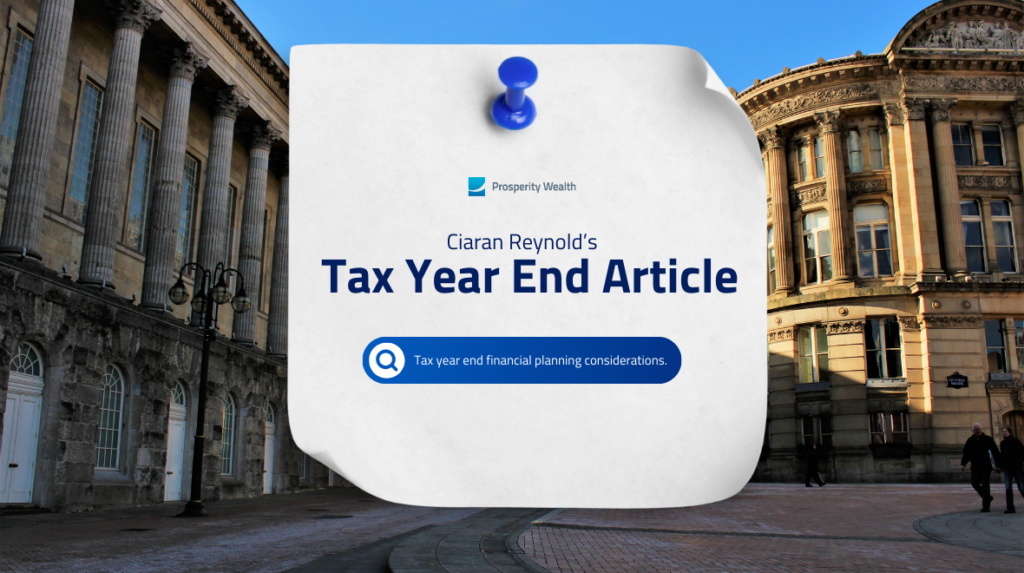- Estate Planning
- , Investments
- , Retirement
- , Services
Tax year end financial planning considerations.
As we approach the end of the current tax year, it provides an opportune time to review your current financial situation and take advantage of any unused allowances before they expire.
Remember, many tax allowances operate on a ‘use it or lose it’ basis, meaning that any unused allowances will not carry over into the new tax year. To ensure you’re making the most of your tax-efficient options, I have compiled a Tax year end check-list to help you navigate the coming weeks and make the most of the available tax allowances.
Pensions
Pension Contributions
Pensions offer one of the most tax efficient ways of saving for your future. This year we saw an increase in the annual allowance to £60,000, meaning you can claim tax relief at your highest marginal rate on pension contributions up to the higher of £3,600, 100% of earnings or £60,000.
Whilst making contributions into your pension can lower your tax bill, they can also be used to restore previously lost personal allowances and help avoid the child benefit tax charge. In addition, the funds within your pension can grow free from capital gains (CGT) and income tax.
Unused annual allowances can be carried forward from the 3 previous tax years, rules apply.
It is not just those who are working that can benefit from tax relief on pension contributions, Consideration can be made to make contributions to those family members who do not currently have relevant UK earnings, including children and grandchildren. A net contribution of £2,880 per year can be made, which will attract basic tax relief of £720, taking the actual contribution to £3,600 per year.
However, it is worth noting, due to the generous tax reliefs available on pension savings, you are unable to access the funds within the pension until you reach 55.
Savings and Investments
ISA
An individual can save or invest into an Individual Savings Account (ISA) in a flexible, tax efficient manner up to the current annual ISA allowance of £20,000. ISAs can hold cash, invest funds as well as individual shares, which can grow free from Capital Gains and Income tax.
ISAs can be accessed flexibly, with no age restrictions on withdrawals. However, the ISA annual allowance operates on a ‘use it or lose it’ basis, meaning any unused allowance cannot be carried over into the new tax year, and will be lost at tax year end.
Therefore, it is important to review yearly ISA subscriptions for the current tax year to ensure all available allowances have been used, whilst beginning to plan a contribution strategy for the 24/25 tax year.
JISA
A Junior ISA can be set up on behalf of an individual under the age of 18, and can be a great way to start saving for a child’s future. Contributions can be made on their behalf up to a maximum of £9,000 annually.
Just like the adult ISA, JISAs can hold cash, invest funds as well as individual shares, which can grow free from Capital Gains and Income tax.
At the age of 16, the child can take control of the JISA, however they are unable to withdraw funds until they reach 18. At the age of 18, the JISA will automatically turn into an ISA.
When the child turns 16, they are also able to open a ‘full’ cash ISA, and benefit from the full adult ISA allowance, meaning between the ages of 16-18, they could take advantage of a total allowance of £29,000.
LISA
A lifetime ISA is a further tax efficient savings account aimed to help individuals save for their first home or retirement.
An individual can save or invest a maximum of £4,000 annually into a LISA, with the government adding a 25% bonus on top, up to a maximum of £1000, with any interest or investment gain received within the LISA being tax-free.
To open a LISA, the individual must be between the ages of 18-39 and contributions can be made to the age of 50. Any contributions made to a LISA will form part of your overall ISA allowance of £20,000. Therefore, if you contribute the maximum £4,000 into a LISA, you will be able to contribute a further £16,000 into an ISA.
As LISAs are designed to assist people saving for their first home or retirement, there are some withdrawal rules to consider. Although you can withdraw fund from the LISA at any time before the age of 60, unless the funds are used to buy your first property, there will be a penalty charge of 25%.
Taxation
Savings allowance
For those savings that are not held within a valuable tax wrapper, Basic rate taxpayers benefit from Up to £1,000 of savings interest tax free. This is reduced to £500 for higher rate taxpayers.
Dividend Allowance
Each individual has a personal tax-free dividend allowance of £1000, meaning that for the first £100- of dividend income received from holding shares in company is tax free. Dividends above this level will be taxed at 8.75% basic rate, 33.75% higher rate and 39.35% additional rate. It is important to review any dividend income received within this tax year to ensure you are utilising your available allowance, as it cannot be carried forward.
Capital Gains Tax (CGT)
The current annual personal exemption for capital gains on disposal of assets is £6,000. Above this amount tax is levied at 10% for basic rate taxpayers and 20% for higher rate taxpayers.
Higher rates are applied for any capital gains made on disposal of second properties, current 14% for basic rate taxpayers and 28% for higher rate taxpayers, although the government announced a reduction in higher rate CGT to 24% in the spring budget.
The CGT personal exemption is another ‘use it or lose it’ allowance, which cannot be carried over into the new tax year, therefore if you are considering disposing of an asset that may attract a CGT liability, it is worth reviewing this with your adviser to ensure you are making full use of your, and your spouse’s personal exemptions.
It is also important to review any capital loses you may have that could offset any capital gains made. Capital losses can be carried forward under certain circumstances.
Personal Allowance
Every individual in the UK has a starting personal allowance threshold, where no income tax is paid of £12,570, which has been frozen until 2028.
For every £2 an individual earns over £100,000 annually, from all income sources, the personal allowance is reduced by £1. Meaning that an individual with earnings of £125,140 will lose their full annual allowance. If you fall into this bracket, now is the time to talk to your adviser as, pension contributions can be used to restore all, or part of your personal allowance.
Marriage allowance
If you are married, or in a civil partnership, and your spouse or partner earns less than £12,570 per year, you may be able to transfer a proportion of your personal allowance to your other half, further reducing their tax bill. You can also backdate your claim for up to 5 years, providing you were eligible for Marriage Allowance in those tax years.
Inheritance Tax (IHT)
Each individual has a nil rate band where no inheritance tax is paid on death of £325,000. In addition to this, there is an additional main residence nil rate band (RNRB) of £175,000 if your main residence is passed, on death, to a direct descendant. IHT is charged at 40% on the value of assets in an estate above these thresholds.
Married couples, or those in civil partnerships are currently exempt from inheritance tax on assets left to their spouse or registered civil partner, with any unused IHT nil rate band also passing on to the surviving spouse or civil partner. Meaning that the surviving part could benefit from an increased nil-rate band of up to £1m.
In addition, there are also a number of annual allowances and exemptions on gifts that can be used to reduce the amount of your overall estate.
- Gifts between UK domiciled husband or wife or between civil partners
- Total gifts up to £3,000 in a year (can be carried forward one tax year
- Small gifts to other recipients up to £250 each in a year.
- Gifts in consideration of marriage or civil partnership ranging from £5,000 from each parent of the couple, to £1,000 from anyone else.
If you would like to discuss your options ahead of tax year end, please contact enquiries@prosperitywealth.com or call 01384 390 039
Ciaran Reynolds | Independent Financial Adviser
ciaran.reynolds@prosperitywealth.com











